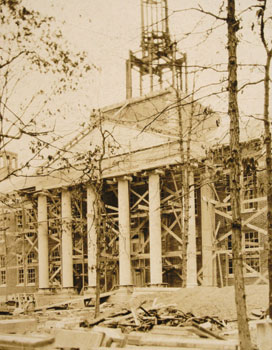Then and now: Green Hall
Lizards, and frogs, and snakes! Oh my! You might be surprised at what turns up on a quick trip through Green Hall’s history. Plus, archival photos of the building.


It’s the center of TCNJ’s administrative operations these days, but for a generation of alumni, Green Hall was the center of the academic world, where you registered for and attended classes, bought supplies and met with professors, commenced each school day and concluded your studies by receiving a diploma. Now in its 80th year of continuous use—but looking like new outside thanks to a recent refurbishment—the building has witnessed more history than can be recounted here. What follows is an admittedly incomplete assemblage of tidbits that we hope will prompt readers to write in with their memories of time spent in Green.
Ground was broken in spring 1930, the cornerstone was set the following May, construction was rushed that summer, and the current campus’ first academic building opened on September 17, 1931. Named for an alumnus and former principal of the Normal School, James M. Green Hall offered “every possible convenience for teaching and learning,” The Signal reported at the time, and for at least its first year housed all classes held on the Hillwood Lakes campus.
The only remaining construction plan shows that Green’s second floor originally included male and female faculty lounges, sewing and cooking classrooms, science labs, a dark room, and a typewriting room. There was a living museum that housed a “miniature menagerie”—everything from salamanders, lizards, and chameleons, to canaries, frogs, and turtles. The museum wasn’t “lacking of monsters” either, The Signal reported in 1951. “Two huge alligators” lived there, as well as a boa constrictor that’s rumored to have escaped on occasion. A bank run by business education majors was also upstairs.
When the Clinton Avenue campus closed, the industrial arts department set up shop—literally—in Green’s basement. By the end of the 1930s one could also find the bookstore down there. Run by Business Manager John Quimby with help from the Student Executive Board, it sold texts, stationery, athletic equipment, banners, and of course, little blue exam booklets.
Before that “great Hillwood myth, the Student Union Building” materialized, students started each school day in Green’s Community Room. “It was the only space for commuters at the time, and residents also stopped there to pick up mail,” recalled Professor Emeritus Leonard J. Tharney ’54. With 900 undergrads passing through daily, one can imagine the chaotic conditions. A mail chute installed behind Green alleviated some of the foot traffic, but Signal editors still railed that the Community Room was “grossly inadequate” for State’s growing enrollment.
Many of the classes held in Green were eventually moved to newer buildings that featured specialized labs and equipment, but Green’s central location ensured its continued role in campus events. The building played a supporting role each spring during step-singing performances: Before juniors took possession of Kendall’s steps from the seniors, those soon-to-be grads melodiously roasted their former professors, many of whom were listening in from Green’s darkened classrooms.
Green’s steps were sacred ground in Tharney’s day. “You weren’t supposed to stand there, because that was where Commencement took place,” he said. Those steps were the setting for numerous Commencement speeches, as well as a few demonstrations (one, in 1990, brought hundreds to Green to protest mandatory cumulative finals).
High above Green’s steps, in the building’s signature clock tower, is the carillon. First presented by student organizations in 1948, then again by Lowell F. Johnson in 1977, the carillon continues to chime the Alma Mater twice daily. Students who follow its strains into Green Hall these days aren’t coming to attend class, but rather to seek financial aid advice, find a place to study abroad, or perhaps replace a lost ID card.
Luckily for them, there hasn’t been a boa constrictor sighting in years.
Posted on November 1, 2011


